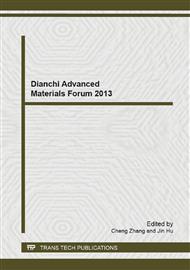p.271
p.276
p.280
p.286
p.291
p.295
p.301
p.305
p.310
Nonlinear Magnetostrictive Effect of Magnetorheological Elastomers
Abstract:
Magnetorheological elastomers (MREs) are a class of smart composites whose mechanical properties can be obviously changed under different magnetic field. Only a few works study its magnetostrictive property, which describes the changes in dimensions of a material in its magnetization. Magnetostriction in the ferromagnetic particle is also called eigenstrain in MREs. It is modeled using the nonlinear function of the magnetization in this article. The eigenstrain due to the magnetostriction is incorporated in the structure of the MREs using a generalized Hookes Law. By means of initial strain, a finite element simulation is presented to describe the magnetostriction of MREs. The results show that the magnetostriction along the magnetic field depends on the magnetization and the volume fraction of particles. As an application, we will present numerical simulations for a magnetostriction and compare these results with measured data.
Info:
Periodical:
Pages:
291-294
Citation:
Online since:
November 2013
Authors:
Keywords:
Price:
Сopyright:
© 2014 Trans Tech Publications Ltd. All Rights Reserved
Share:
Citation:


